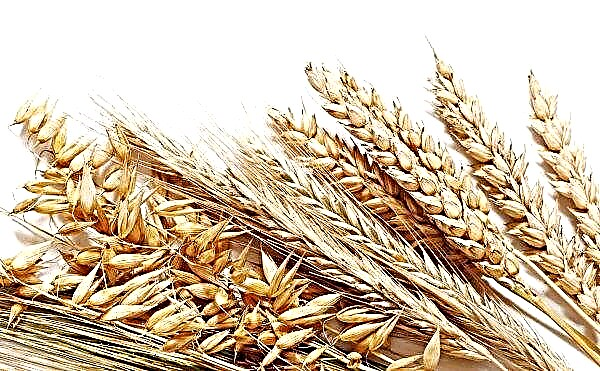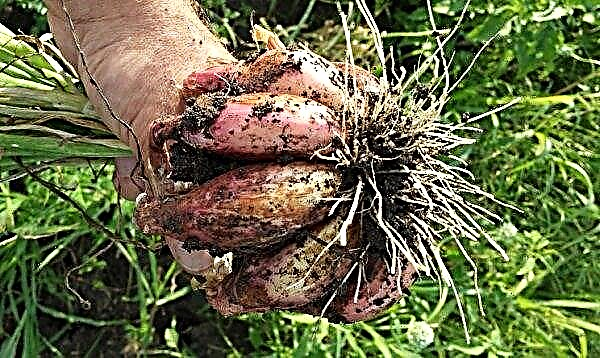Chickens are distinguished by fairly good health and unpretentiousness in care. First of all, young growth perishes, as its immunity is still not sufficiently developed.
In order to protect the stock from all kinds of infections, there are broad-spectrum antimicrobials, for example, Baytril from the manufacturer Bayer.
Composition and form of release
The preparation contains the following components:
- enrofloxacin - 5 or 10%;
- butanol 1%;
- potassium alkali;
- water for injections.
Antimicrobial agent of a wide spectrum of action "Baytril", produced in the form of solutions:
- for injection - 5%;
- for oral administration - 10%;
- for additives in feed - 10%.
 For the treatment and prevention of young animals, Baytril is usually used for oral use (10%). This transparent product, light yellow in color, is poured into glass containers with a volume of 30-100 ml.
For the treatment and prevention of young animals, Baytril is usually used for oral use (10%). This transparent product, light yellow in color, is poured into glass containers with a volume of 30-100 ml.The active substance of the drug is enrofloxacin (1 ml of the drug contains 100 mg of the substance), has an antimicrobial effect on a large number of different bacteria. It belongs to fluoroquinolones, substances similar in their mechanism of action to antibiotics, but, unlike the latter, which have no natural analogues.
Did you know? In ancient Egypt, mold bread was used in the treatment of inflammatory processes caused by burns. The Egyptians probably knew about the action of the simplest natural antibiotic - penicillin — more than 3 thousand years earlier before Alexander Fleming, who discovered the substance in 1929.
What diseases are prescribed?
As already mentioned, the drug has a wide spectrum of antimicrobial action, is effective in the treatment of diseases caused by gram-positive and gram-negative bacteria. We will describe in more detail about the most common poultry diseases in which “Baytril” is prescribed.
Colibacillosis
A dangerous infectious disease that can under certain circumstances cause death to one third of the total population. It is transmitted in all possible ways, even through the eggshell.
The main signs of the disease in birds:
- lack of appetite;
- thirst;
- the beak acquires a blue hue;
- diarrhea, as a result of which the cesspool is constantly dirty.

Salmonellosis
One of the most famous and dangerous avian diseases that can be transmitted to humans. Quite often, infected eggs become the cause of human infection.
In the case of salmonella in chickens, the symptoms resemble gastroenteritis:
- lack of appetite;
- bloody diarrhea with mucus and pieces of food that have not been processed;
- swollen belly.
Of the other characteristic symptoms of the disease, note:
- lethargy and weakness;
- poor development;
- loss of fluff, up to complete baldness;
- dyspnea;
- most infected chickens die, and those that survived remain underdeveloped and noticeably unhealthy.

Pasteurellosis
The disease is most dangerous for young animals aged 3.5-4 months. The cause of the disease can be wild birds, sick "relatives" of the livestock, non-compliance with hygiene requirements in the chicken coop.
Full compliance with sanitary requirements and hygiene procedures are the first and most important means of combating the disease. The most characteristic signs of the disease:
- plumage dims and loses smoothness;
- symptoms of acute respiratory infections - hoarseness, panting;
- limp gait;
- mucous foam flows from the beak;
- body temperature reaches 42.5 ° C and above.
Did you know? In the remains of the oldest mummies found in the territory of modern Sudan, an antibiotic tetracycline was discovered. Ancient Egyptian experts were able to get the substance from beer.
Streptococcosis
Streptococcus microorganisms cause the disease. They are dangerous not only for adult chickens, chickens, but also for embryos.
The disease can occur in such forms:
- Sharp. It is also called blood poisoning, since the hematopoiesis function is impaired in the chicken body.
- Chronic With it, the bird turns into a carrier of streptococcosis.
- Capsular, or asymptomatic. The chick dies after a day without the manifestation of preliminary symptoms.
- dirty feed;
- equipment for the chicken house with violations;
- poor and unbalanced nutrition;
- avitaminosis;
- microtrauma.
- unhealthy thinness;
- retardation;
- slowness and impaired motor function.

Staphylococcosis
Symptoms are similar to bird cholera. The main cause of infection of birds is microtrauma on the skin or other tissues. The pathogen penetrates through them, causing inflammation.
For humans, approximately half of all bacterial strains are dangerous, namely those that secrete enterotoxins. These toxins, in turn, can cause a person to be infected by entering their body with infected meat.
Important! If within three days the treatment has failed, and there is no improvement in the bird’s health, after consultation with a specialist, it is necessary to change the antibiotic.
Ulcerative enteritis
The causes of the disease are reliably unknown to this day. It is believed that this is a complex disease, the causative agent of which may be secondary intestinal bacteria and some viruses.
Broilers most susceptible to the disease are 15-50 days old. Signs by which you can recognize the disease:
- the bird has its head and wings;
- complete immobility;
- the droppings are almost black in color, with virtually no traces of moisture, but with obvious signs of blood.
 If the disease is started, the bird completely refuses food, as a result of which it perishes. Until then, the appetite is quite good, but the feathered one still stops in growth.
If the disease is started, the bird completely refuses food, as a result of which it perishes. Until then, the appetite is quite good, but the feathered one still stops in growth.Mycoplasmosis
The most dangerous bird disease, the cause of which can be even a minimal violation of sanitary standards. The incubation period is 3 weeks. The causative agent - the simplest membrane-free mycoplasma bacterium - can be found on the ground, in grass, waste, on various plants.
Did you know? The big problem, as predicted by the discoverer of antibiotics, Alexander Fleming, was the phenomenon of resistance - addiction to the action of antibiotics. In order for the drugs to continue to have a therapeutic effect on the body, it was constantly necessary to discover new active substances, but every year it became more and more difficult to do. As a result, in 2015, a new antibiotic, teixobactin, was discovered, for the first time in 30 years.
Among the characteristic features are the following:
- mucous foam from the nose, sneezing;
- signs of acute respiratory infections;
- Red eyes;
- lack of appetite, lethargy, weakness;
- diarrhea of a yellow-green hue.

Instructions for use and dosage for chickens
“Baytril” is used both for the treatment of already sick birds, and for the prevention of disease, in case of danger or suspicion of the possibility of disease.
For treatment
For treatment, the drug is diluted in water. The table below shows how to give medicine to chickens, depending on the concentration of the drug. In all cases, the specified amount of the drug should be diluted in 100 liters of water.
| The volume of the drug, ml | Drinking mode, repeatability in hours |
| 50 | 24 |
| 100 | 12 |
| 200 | 6 |
| 400 | 3 |
If you want to calculate the dosage of the drug yourself, you should use this formula: X = K x M / 10, Where:
- X - the volume of the drug "Baytril" (10%) for oral use, (ml);
- To - the total number of birds in the stock, (pcs.);
- M is the average weight of one bird, (kg).
Important! Before starting the course of treatment, the drinkers should be completely drained and rinsed under running water, and only after that water with the drug is poured into them.
For prophylaxis
As a prophylactic, Baytril is used as follows: 2 ml of the drug is dissolved in 4 l of water and given to chickens on the 2nd to 4th day after birth. Then, on the 5th – 9th day, young animals are fed with any vitamin complex to enhance immunity and to avoid the occurrence of vitamin deficiency.
Contraindications
Basically, the bird tolerates drug treatment quite normally. But, as with any drug, there are some contraindications.
If immunity to quinolones is known, the drug cannot be used, otherwise a hyperreaction to the active substance is very likely, which, in turn, often leads to the following consequences:
- diarrhea;
- weakness and lethargy;
- lack of response to various external influences;
- complete lack of appetite.

To avoid possible complications when taking the remedy, during the treatment period you should not change the usual diet of the bird and its usual living conditions, protect chickens from stressful situations.
The drug is contraindicated in a bird having such diseases and pathologies:
- central nervous system diseases;
- problems with the liver and kidneys;
- poor development of cartilage and bone tissue.
Important! During the period of taking the drug, the process of digesting food may be disturbed, since the intestinal microflora changes.
Slaughter of a bird can be carried out only on the 12th day from the day of the last intake of the drug, eggs can be eaten after 9 days. All poultry products, for some reason received before this time, should be taken for processing, after which they are fed to livestock, whose products are not eaten by humans.
Analogues of the drug
Enrofloxacin as an active substance is also used in preparations of other manufacturers:
Storage conditions
The drug is stored in the temperature range +5 ... + 25 ° C for 36 months from the date of manufacture. The shelf life of the vial after packaging is 28 days.
Although, as mentioned above, the drug "Baytril" is well tolerated, and the likelihood of an overdose is negligible, you should not independently treat the bird. To establish the diagnosis and, accordingly, the appointment of treatment, there are specialists - veterinarians, they should be consulted.
Remember that even the most modern drugs that are considered harmless are primarily drugs, and you must handle them with appropriate care.












